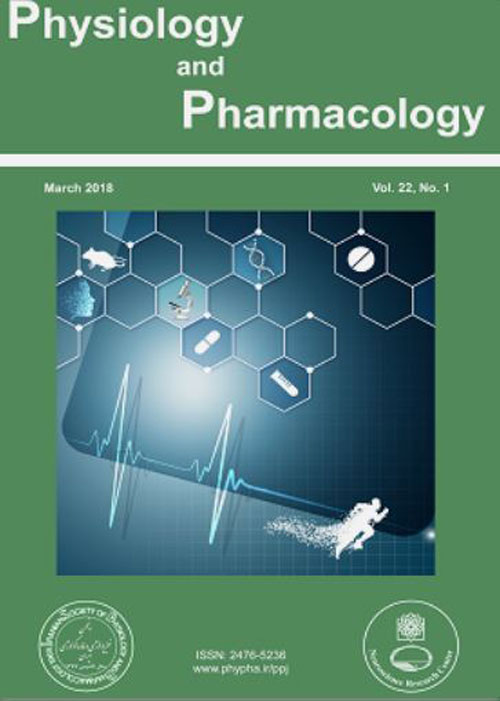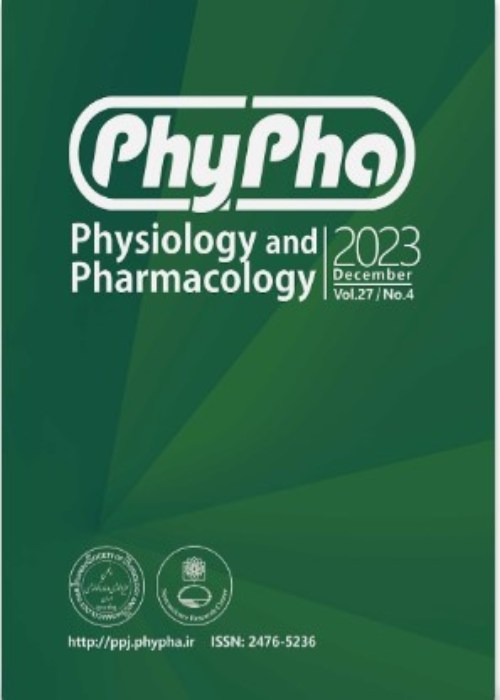فهرست مطالب

Physiology and Pharmacology
Volume:22 Issue: 4, Dec 2018
- تاریخ انتشار: 1397/09/11
- تعداد عناوین: 8
-
-
Pages 213-218IntroductionTo improve our understanding of dizziness, its assessment, as well as its management to identify the appropriate treatment in order to reduce the costs and to increase the patients’ quality of life.MethodsA single blind parallel group randomized controlled trial was conducted on 164 participants with dizziness. One group received 25mg/ml promethazine and another received 5mg/ml diazepam. To assess the severity of dizziness, Visual Analog Scale was used prior to and two hours after treatment.ResultsBoth promethazine and diazepam had significant effects on decreasing the severity of dizziness, i.e. the severity score decreased from 9.31 to 1.81 in promethazine versus 9.33 to 4.50 in diazepam (P<0.001).ConclusionA single IV dose of promethazine is more effective in reducing vertigo as compared with diazepam.Keywords: Diazepam, Dizziness, Promethazine, Vertigo, Vestibular
-
Pages 219-227IntroductionAlzheimer’s disease (AD) is a common progressive, neurodegenerative disorder with no preventive or curative therapy until now. Use of natural products as an important source of neuroprotective flavonoids against AD has been considered recently. In this study, the effect of Mespilus germanica leaves (MGL) flavonoids treatment on memory dysfunction and apoptosis in the amyloid beta (Aβ)-treated rat was investigated.MethodsForty-eight male Wistar rats (220-250g) were divided into 6 groups (n=8): saline, Aβ, treatment (5, 7.5 and 10 mg/kg MGL flavonoids) and positive control group. Step through the passive avoidance test was performed on the 22nd day to examine learning and memory. Immediately afterward, the animals were killed and their brains were removed to measure the levels of cytochrome c in brain homogenate.ResultsOur results showed significant improvement in passive avoidance task as flavonoid (10mg/kg) increased step-through latency (P=0.003) and decreased the time spent in dark compartment (P=0.001) significantly. In addition, the levels of cytochrome c which was significantly increased in the Aβ-injected group was reduced remarkably in the flavonoid treatment group (P=0.029).ConclusionTherefore, MGL flavonoid can improve Aβ1-42 induced memory dysfunction in rats and its effect might be partially due to their role in decreasing apoptosis.Keywords: Alzheimer’s disease, Amyloid beta, Flavonoids, Passive avoidance, Cytochrome c, Mespilus germanica
-
Pages 228-239IntroductionThe use of standard rodent model, allows for the understanding of neuronal injury physiopathology and helping development of therapeutic strategies. Because of eliminating technical problems, we designed a modified impactor device with ability to induce different degrees according to kilodyne from very mild to very severe of spinal cord injury (SCI) and traumatic brain injury (TBI) models in rat.MethodsFor standardization and determining of optimal performance of the device to induce varying injuries, 47 adult male Wistar rats were used, and 8 different forces were applied in spinal cord and brain tissues.ResultsThe hematoxylin and eosin and 2, 3, 5-triphenyltetrazolium chloride (TTC) results demonstrated that by increasing the level of forces, histological changes in the spinal cord and brain were significantly enhanced. Different injuries had significant effect on the Basso-Beattie-Brenham and elevated body swing test outcomes, and there were significant differences between groups in comparison with control group.ConclusionOur results showed that the modified device could be valid to produce precise SCI and TBI models, goal to replicate SCI and TBI in humans as much as possible. However, it might be considered that aspects of SCI and TBI models are complicate and more examination is necessary.Keywords: Spinal cord injury, Traumatic brain injury, Modified impactor
-
Pages 240-246IntroductionCholinergic neuronal deficiency is one of the main causes of Alzheimer's pathology, which leads to learning and memory impairment. Scopolamine is a muscarinic cholinergic antagonist commonly used to induce Alzheimer's disease (AD). Insulin also regulates learning and memory function. Thus, the aim of this study was to determine the effect of central administration of insulin on passive avoidance learning.MethodsIn this experiment, fifty-nine rats were divided into 6 groups: (1) intact, (2) sham, (3) scopolamine-saline, (4) scopolamine-insulin4, (5) scopolamine-insulin8 and (6) scopolamine-insulin16. In addition, scopolamine (70nmol/2μl) was injected into the right lateral ventricle, before the retrieval test of the inhibitory avoidance task. Then the effects of three doses of insulin (4, 8 or 16 mU/2μl) were investigated on the passive avoidance learning in an amnestic model induced by scopolamine.ResultsOur results indicate that the retrieval of passive avoidance memory was significantly improved by intracerebroventricular administration of insulin in 4 and 8 mU/2μl doses but not in 16 mU/2μl.ConclusionThese results confirmed that insulin could improve the retrieval phase of passive avoidance memory that was impaired by scopolamine.Keywords: Insulin, Scopolamine, Learning, Memory, Passive avoidance learning
-
Pages 247-253IntroductionGinger has shown anti-nociceptive effects. Here we investigated the possible involvement of GABAA receptors in anti-nociceptive effect of ginger using muscimol (GABAA agonist) and picrotoxin (GABAA antagonist) in rats that received ginger. The pain sensitivity was evaluated by formalin test.MethodsThirty-five male Sprague-Dawley rats were randomly divided into 7 groups (n=5): sham1 (received distilled water. PO); sham2 (received water + 0.75μl artificial cerebrospinal fluid by intracerebroventricular (ICV) injection; experimental1 (received ginger at 50 mg/kg/day, PO); experimental2 and 3 (received ginger+ 0.75μl of 250 or 500ng/rat muscimol by ICV injection); experimental4 and 5 (received ginger+ 0.75μl of 250 and 500ng/rat picrotoxin by ICV injection). On day 16 and 30min after ICV injections, formalin test was performed on all rats.ResultsGinger significantly reduced pain sensitivity in both phases of formalin test in comparison to sham1 and 2. In early and late phase, both doses of muscimol reduced pain sensitivity as compared to the ginger group. Picrotoxin at 250ng/rat+ ginger reduced pain sensitivity as compared to the group that received ginger, in both the early and the late phases of the formalin test. Picrotoxin at 500ng/rat+ ginger increased pain sensitivity in the early phase and late phase of formalin test as compared to the ginger group.ConclusionAqueous- alcoholic extract of ginger has significant analgesic effects in late phase of formalin test and GABAA receptors may be involved in this regard.Keywords: Ginger, Muscimol, Picrotoxin, Pain sensitivity, Rat
-
Pages 254-268IntroductionCertain types of chronic mental stress impair memory. On the other hand, crocin is introduced in the medical literature as an effective component of saffron with remedial effects on memory impairment. This study investigated the effects of crocin on spatial and cognitive memories, locomotor activity, novel recognition conditions and serum corticosterone levels in rats under chronic isolation stress.MethodsMale rats were randomly allocated to the five groups of control, sham, isolation stress (St.I), St.I-C30 and St.I-C60. The latter two groups were exposed to chronic isolation stress (6h/day) receiving two levels of crocin (30 and 60 mg/kg, respectively) over a period of 21 days. The object location and novel object recognition tests (OLT and NOR) were used to evaluate spatial and cognitive memories, respectively.ResultsThe OLT results revealed that chronic isolation stress led to significantly decreased locomotor activity in all the stressed groups; the NOR test, however, yielded similar results only in the St.I group. Moreover, isolation stress was found to lead significant declines in spatial and cognitive memories. Finally, crocin administration led to improvements in impaired memory in St.I-C30 and St.I-C60 groups. There were significant enhancements in serum corticosterone levels in the St.I and St.I-C30 groups as compared with the control group.ConclusionOur findings indicate that spatial and cognitive memory impairments are strongly affected by isolation stress and crocin especially at its high dose of 60 mg/kg, exhibits better protective effects against cognitive memory deficit induced by chronic isolation stress.Keywords: Crocin, Memory, Isolation stress, Rat
-
Pages 269-278IntroductionNephropathy is defined as rational loss of renal function related with glomerulosclerosis and declining glomerular filtration rate. Inflammation and oxidative stress play a critical role in nephropathy. Plantago major has antioxidant effects. The aim of present study is the investigation of the effect of Plantago major hydro-alcoholic extract on the oxidative stress and renal function in kidney of rat.MethodsRats were divided into five groups: control (Co), doxorubicin (DOX), doxorubicin+vitamin E (DOX+Vit E), 600mg/kg Plantago major (PM)+doxorubicin (PM600+DOX), 1200mg/kg Plantago major (PM)+doxorubicin (PM1200+DOX). DOX (5mg/kg, IV), Vit E and PM extract (600 and 1200mg/kg, PO) were administrated for 35 days. Finally, urine, blood samples and renal tissue were collected to measurement of redox markers, functional parameters and renal index percentage.ResultsThe renal superoxide dismutase (SOD) activity, total thiol and functional parameters significantly reduced and malondialdehyde (MDA) concentration increased in DOX group in comparison with control group. The renal SOD, catalase activities and total thiol content were significantly increased and MDA level decreased in PM treated groups along with DOX group in comparison with DOX group. The functional parameters significantly enhanced in treated groups with PM in comparison with the DOX group. The extract did not relive enhanced % renal index induced by DOX.ConclusionHydro-alcoholic extracts of PM, specially at its high dose led to an improvement in DOX-induced renal function and oxidative stress.Keywords: Doxorubicin, Plantago major, Oxidative stress, Renal function
-
Pages 279-291IntroductionThe aim of the study was to investigate the structural and hemodynamic changes as well as cardiac transcriptional profile of the key regulatory proteins, sirtuins family (SIRT1-7), in adaptive and mal-adaptive phases of left ventricular hypertrophy (LVH).MethodsLVH was induced in male Wistar rats (190±20g) by abdominal aortic banding. The third and sixteenth weeks post-surgery were considered as adaptive and mal-adaptive phases of hypertrophy (H3w and H16w groups, respectively). Blood pressure (BP) was recorded through the carotid artery catheter. Cell area and fibrosis were assessed using haematoxylin/eosin and Masson trichrome staining, respectively. The sirtuins mRNA levels were quantified using quantitative RT–PCR technique.ResultsH3w rats had a higher systolic and diastolic BP, cardiomyocytes area and heart to body weight ratio (HW/BW) compared with control (intact animals). Although cell size and HW/BW increased in the H16w group, systolic and diastolic BP did not change significantly in comparison with control. In H3w group, SIRT1/3/6/7 mRNAs levels increased significantly. In H16w group, SIRT1/3/5/6/7 mRNAs levels declined in comparison with H3w group. SIRT2 and SIRT4 mRNA levels did not change significantly among the experimental groups.ConclusionDuring progression of cardiac hypertrophy transcriptional profile of sirtuins changes in parallel to structural and hemodynamic parameters. Therefore, it can validate sirtuins as the pharmacological targets for the treatment of pathological LVH.Keywords: Hypertension, LVH, Adaptive hypertrophy, Mal-adaptive hypertrophy, Sirtuins 1-7


